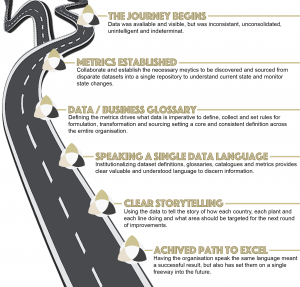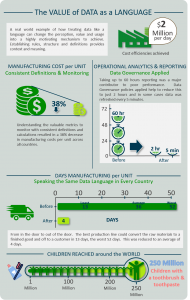 DATA IS A LANGUAGE
DATA IS A LANGUAGE
A Guide to Establishing Successful Data Governance
Its critical to understand the reason, value and why data is a language. This is needed as a foundation in your view of Language Governance and how this will, in turn, influence your future interpretations of what Data Governance is (and isn’t).
Data as a Second Language: A First Hand Experience…
Back in 2001, I was lead on a manufacturing operations efficiency project with Cognos. At the time and in this organisation, “data” was owned by the finance office, especially since it was about cost efficiencies.
This project quickly identified a significant pain point for the business.
The cost of the same product across multiple countries varied greatly and the organisation did not have a complete view on why this was occurring. Of course, the team knew that the cost of a singular product should be very similar no matter where and thus the control of costs at individual locations was being impacted. Further to this the capability of the organisation overall to make consistent decisions was also being affected. In simple terms, we knew that the cost overall was too high, but we didn’t know how or what the issues were, let alone to understand where to address them and who to make accountable.
The first thing we did was establish the current analytics for the target product – children’s toothbrush and toothpaste lines: toothbrushes per second per production line, cost of raw material per kilo per second per line, maintenance costs per second per line, breakdown costs per second per line, direct labour costs per second per line – we had 33 different metrics we calculated for the current state, but you get the picture. We were running this program out of Florida, but it was a global manufacturer with plants in 24 counties. The objective was efficiency, consistency and controllability by production line in order to bring the total cost of product down to a level to get a toothbrush and toothpaste in every child’s hand!
The spreadsheet of metrics was like the movie Matrix. It was awesome and it told a story. There were the Neo’s (smashing the stats like Superman), the Morpheus’s (believers but never achieving), the Cypher’s (nay-sayers) and all the other characters in between. The analytics drove our priorities and identified our problem children, but how best to get our objectives and messages across the cultural and language barriers?
The Matrix Analogy – Enabling a Unified Understanding
One of the team suggested using movie analogies, and of course the Matrix had made it through most countries by then, so we used it to tell our story. Our team was the crew of the Nebuchadnezzar and each pillar of individuals responsible for a line of production was another hovercraft. We were in this together, reading the Matrix of analytics heading to the common goal. This enabled us to set the scene and to enable a common understanding of the data, the analytics, the objectives and where the numbers needed to go.
Through this, we were able to describe and define the calculations of the measures, who was responsible for each measure and the data needed for each element of the measure, where the data was derived, the collection and the storage. This established our pragmatic policies for our project’s Data Governance.
These policies allowed us to have a common set of definitions for data sources, data elements, calculations and transformations. This led to the capability of easy lineage of the data and then the owner of those data sets. This made the accountability of the metrics and KPI’s very easy to apply.
The Myth of Data Governance – A Holistic Red Herring
A myth of Data Governance is that it is holistic, making it difficult to develop policies and then even more difficult to apply. This is not the case, we can establish small foundational pieces project by project, which help to define the corporate information governance strategy in the future.
 As we progressed through the movie, the hovercrafts identified anomalies in the Matrix, individual and unique scenarios that needed to be addressed. Because we had established Data Governance, the traceability of the data was simplified and the identification of the problem was like a lighthouse, it also meant the persons accountable and responsible were also unquestionable. With the identification of the area and the responsible parties out of the way, we could objectively come together and address the issue with open and honest ideas, eliminating risk and political games.
As we progressed through the movie, the hovercrafts identified anomalies in the Matrix, individual and unique scenarios that needed to be addressed. Because we had established Data Governance, the traceability of the data was simplified and the identification of the problem was like a lighthouse, it also meant the persons accountable and responsible were also unquestionable. With the identification of the area and the responsible parties out of the way, we could objectively come together and address the issue with open and honest ideas, eliminating risk and political games.
We used the Matrix to help us form a story, but it was the data that did the story telling. The data was used as a language, a separate language that everyone needed to learn. We created our own grammar and spelling by using the Matrix, which enabled us to establish the sentence structures, nouns and verbs, adjectives and adverbs. This made up our Data Governance. Once we established our sentence structures, it enabled us to have a form of data literacy and common definitions and understanding across the countries, languages, departments and organisation levels, which in-turn led us into defining the data quality requirements, data lineage, responsibilities and ownerships of each sets of data.
We weren’t racing to free people from the Matrix, but we were racing to put a toothbrush and toothpaste in every child’s hand. Six months after our first day, the teams were able to reduce production costs for these two products by US$2 million a day, resulting in toothbrushes and tubes of toothpaste delivered into the hands of 250 million children!
The Clear-Cut Benefits for Your Company
As we can see data does function like a language.
From our Matrix analogy, treating data as a language enabled our team to simplify the complexity of data affecting multi-site product cost variations by crafting a unified business vocabulary. Regardless of which department you’re in, your global location or the type of locally generated data by that department, the ability to use a common agreed set of definitions (i.e. a language) is an instrumental driver of Data Governance, ensuring you can trust your data.
We use it to communicate, to describe, to argue and to story tell. Without grammar, rules for spelling and sentence structure any written or spoken language (i.e. English, Mandurian, Spanish) would be incomprehensible. Therefore, data needs governance for exactly the same reasons; to make it meaningful, understandable and translatable.
Ascention Shares Experience
The concept of Data As A Second Language is a useful starting point to review your organisation’s Data Governance effectiveness. The team at Ascention is always willing to share our experiences to assist your team’s progress – simply contact us to start an informal no obligation discussion.
Contact Us
Address: 201/10-12 Clarke St, Crows Nest, NSW 2065
Telephone: +61 2 8004 6475
Email: info@ascention.com
Website: www.ascention.com
Share this information – click HERE to download this article as a PDF to share with colleagues

